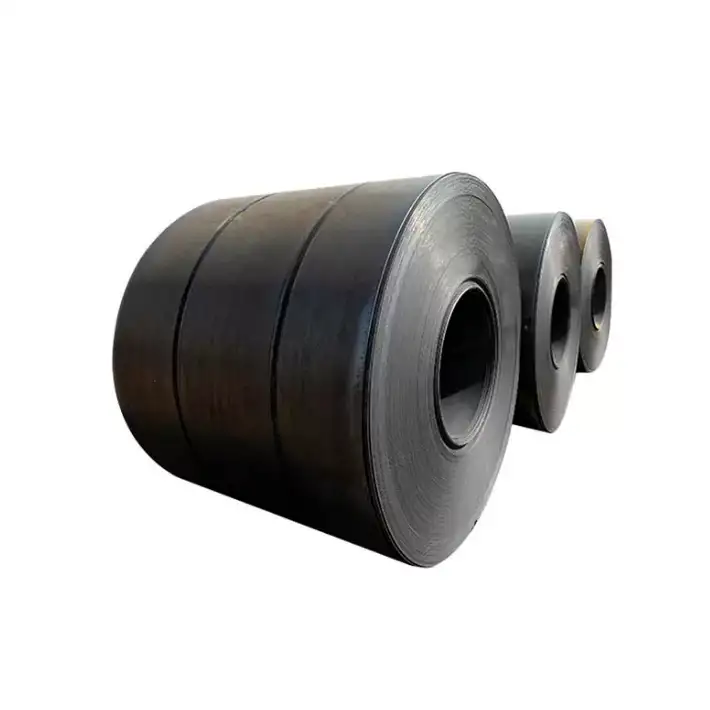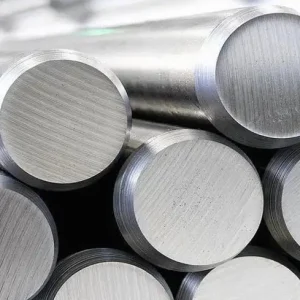AISI/SAE 1045 cold-rolled coil is a medium-carbon, high-strength carbon steel commonly supplied in coil form for precision parts, shafts, gears, and structural components where a balance of strength, toughness, and machinability is required. When supplied in cold-rolled condition, 1045 delivers tighter thickness tolerances, improved surface finish, higher yield strength, and better dimensional consistency than hot-rolled material; it is readily heat-treated to reach a wide range of mechanical properties. For buyers seeking factory-direct supply from China, MWAlloys offers 100% factory pricing with available stock and rapid shipment for standard coil sizes.
What is 1045 steel?
1045 is a medium-carbon plain carbon steel in the SAE/AISI designation series. Its carbon content puts it in the range that allows good balance between strength and ductility while permitting through-hardening by conventional heat treatment. Cold rolling produces coils with improved surface quality and closer dimensional control compared with hot-rolled coils, and that makes 1045 cold-rolled coil attractive for fabrications that need a finished surface and predictable mechanical performance.
Chemical composition (nominal / typical ranges)
| Element | Typical range (wt.%) | Notes |
|---|---|---|
| Carbon (C) | 0.42 – 0.50 | Medium carbon level; controls hardness & strength. |
| Manganese (Mn) | 0.60 – 0.90 | Strengthener and hardenability aid. |
| Phosphorus (P) | ≤ 0.04 | Impurity limit; kept low for toughness. |
| Sulfur (S) | ≤ 0.05 | Controlled to improve machinability (sometimes higher in free-machining variants). |
| Iron (Fe) | Balance (≈ 98.5–99.0) | Base metal. |
| Other (Si, Cu, Ni, Cr) | Trace amounts | Usually <0.40 each; depends on mill practice. |
Source technical data and typical composition ranges are consistent with standard data sheets for SAE/AISI 1045.
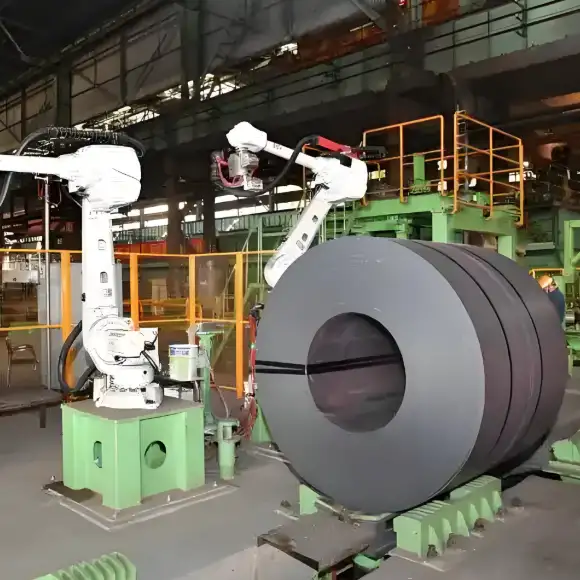
Material properties
Note: Property values depend strongly on heat treatment (annealed, normalized, quenched & tempered). The table below gives representative values for cold-rolled, normalized and quenched-and-tempered conditions used by designers.
| Property | Cold-rolled / normalized (typical) | Quenched & tempered (typical) | Units / remark |
|---|---|---|---|
| Density | 7.85 | 7.85 | g/cm³ |
| Tensile strength (UTS) | 550 – 700 | 700 – 950 | MPa |
| Yield strength (0.2% offset) | 300 – 450 | 450 – 700 | MPa |
| Elongation (A₅₀) | 12 – 18 | 8 – 16 | % |
| Hardness (Brinell) | 150 – 220 HB | 200 – 320 HB (depending on temper) | HB |
| Modulus of elasticity | 205,000 | 205,000 | MPa |
| Poisson’s ratio | 0.27 – 0.30 | 0.27 – 0.30 | — |
These ranges align with standard datasheets and engineering tables for 1045/C45 grade steels; final selection must use supplier certification values for design calculations.
Typical specifications & coil dimensions
| Item | Typical value / range |
|---|---|
| Standard designation | SAE-AISI 1045 (also referred as C45, 1.0503 / 1.1191 depending on EN variant) |
| Common standards referenced | SAE/AISI, EN (C45 / 1.0503 / 1.1191), JIS S45C, GB/T (China grade 45 & equivalents) |
| Coil width | 600 mm – 1,650 mm (typical mill ranges; custom widths possible) |
| Coil thickness (cold-rolled coil) | 0.35 mm – 3.0 mm (thin strip), heavier gauges up to ~6 mm in some cold-rolled product lines |
| Coil inner diameter | 508 mm (standard) or 610 mm — depends on mill tooling |
| Coil weight | 3 – 12 metric tonnes typical; jumbo coils higher |
| Surface finish | #1 (mill), bright cold-rolled; additional polishing or annealing pickling on request |
| Tolerances | Per mill standard and purchaser spec (tight tolerances are main advantage of cold-rolled) |
For final procurement, always request a material test certificate (MTC) and dimensional tolerance sheet from the mill.
International equivalents
| SAE / AISI | EN / DIN | JIS | China (GB) | Common synonyms |
|---|---|---|---|---|
| 1045 | C45 (1.0503), C45E (1.1191), C45R (1.1201) | S45C | 45# (or Q235/45 variant in some specs) | G10450, S45C, CK45 |
Cross-reference tables and conversion charts from international steel directories show direct equivalence between SAE 1045 and EN C45 family grades; minor chemistry or delivery condition differences may exist and must be confirmed for critical applications.
Cold rolling: production effects on microstructure and properties
Cold rolling reduces thickness by plastic deformation at ambient temperature and produces:
-
Strain-hardened microstructure near the surface and through thickness depending on reduction ratio; cold rolling increases yield strength and hardness relative to the annealed/hot-rolled state.
-
Improved surface finish and closer thickness tolerances, which reduces downstream machining and finishing costs.
-
Residual stresses introduced by cold working; these can be relaxed by light annealing or temper rolling to control flatness and mechanical behavior.
-
Anisotropy in mechanical properties (directional differences) — mill certification should indicate rolling direction properties where important.
Designers must consider that heavy cold reduction reduces ductility; typical practice is to perform a light anneal or tempering sequence before tight-tolerance finishing if component forming is required later. (Industry reference material on cold-rolling effects supports these points.)
Heat treatment: common cycles and expected outcomes
Annealing (softening): Heat to ~680–720°C, hold to homogenize, furnace cool or controlled cool to obtain a soft ferrite-pearlite microstructure — results: improved machinability and ductility; hardness drops to annealed levels.
Normalizing: Heat to 840–880°C and air-cool — refines grain size; used when improved toughness and uniform microstructure needed.
Quenching & tempering: Hardening by heating to 820–860°C, quench (oil/water) then temper at 400–650°C depending on required hardness/toughness balance — widely used to reach higher tensile strengths and wear resistance.
Because a cold-rolled coil is often supplied in a deformed/strain-hardened state, mills may offer mill annealed coils (soft) or skin-passed coils (slight temper rolling) according to buyer needs. Material certification should include post-treatment condition.
Machinability, weldability and joining notes
-
Machinability: 1045 has moderate machinability; it machines well when annealed but becomes more difficult after hardening. For high volume turning, specifying a free-machining variant (sulfur added) may be preferable.
-
Welding: Welding of 1045 requires preheating and controlled interpass temperatures to avoid cold cracking and loss of toughness due to high carbon content. Post-weld heat treatment (PWHT) is recommended for critical weldments.
-
Brazing/fastening: Standard joining methods apply, but threads and minor features are often rolled or cut from normalized material to avoid work-hardening issues.
Provide weld procedure specifications from the purchaser for critical assemblies; mill MTCs may include recommended practices.
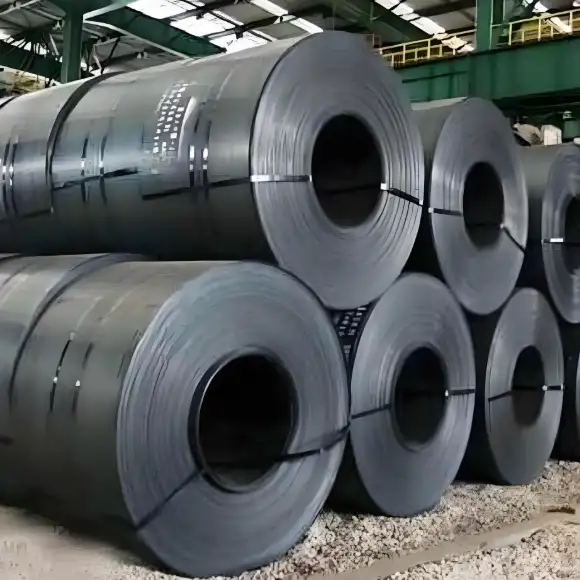
Typical applications
-
Shafts, axles, spindles, and tie rods
-
Gears, pins, and couplings (after appropriate heat treatment)
-
Machinery components requiring higher strength than low-carbon steels
-
Cold-formed parts where improved surface finish is mandated
-
Automotive parts (non-safety critical) and heavy equipment components
Because of its balance between strength, machinability and cost, 1045 is a staple material in mechanical engineering applications.
Surface finish, tolerance control and inspection checkpoints
Buyers should inspect or require certificates for:
-
Surface condition (scratches, decarburization, scale removed)
-
Thickness tolerance (mill sheet/tolerance chart)
-
Width and camber tolerances
-
Mechanical test results (UTS, yield, elongation) — certified by supplier MTC
-
Chemical analysis (spectro report) confirming C, Mn and impurity limits
-
Flattening and residual stress reports for high-precision strips
Cold-rolled coils are typically shipped with protective inner/outer wraps, and in seaworthy packaging for export. Ask the mill for photographs and test certificates before shipping if quality control is critical.
2025 price comparison (US / Europe / China)
Context and caveats: Coil prices fluctuate with scrap values, energy costs, tariffs and regional demand. Cold-rolled coil (CRC) typically trades at a premium to hot-rolled coil (HRC) because of added processing. The figures below summarize market spot ranges in 2025 from industry trackers and trade commentary; use them for budgeting, not final procurement.
| Region (2025 typical spot) | Cold-rolled coil (CRC) price per metric tonne (USD) | Notes / drivers |
|---|---|---|
| United States (Q2–Q3 2025) | $1,050 – $1,200 / t | Domestic mills, tariffs and inland freight add cost. Reported CRC ranges mid-2025 in this band. |
| Europe (EU domestic, mid-2025) | $1,000 – $1,150 / t | Regional scrap and energy prices, import flows. |
| China (exportable domestic CRC, mid-2025) | $560 – $820 / t | China domestic CRC often lower due to scale; export offers vary with quotas and shipping. |
How to interpret:
-
The US and EU prices carry higher processing, labor and logistics costs and sometimes policy-driven premiums.
-
Chinese mill export offers often undercut Western domestic prices — this is the reason many international buyers source factory-direct from Chinese producers (subject to duties and quality checks).
-
Cold rolled coil for 1045 (medium carbon) may see additional mill premiums for tighter chem spec and special finishing.
Recommendation: Request firm quotations (FOB/CIF) from multiple mills and ask for current scrap-linked index basis to benchmark offers.
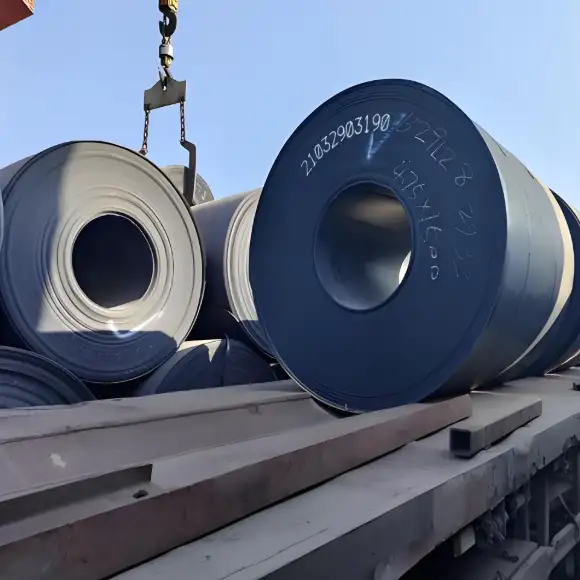
Purchasing tips, packing and MWAlloys offering
Purchasing checklist
-
Confirm exact chemistry and delivery condition (annealed, normalized, skin-passed).
-
Obtain Mill Test Certificate (EN 10204 3.1 or equivalent) with batch spectro analysis.
-
Specify coil geometry: width, thickness, ID, weight and surface finish.
-
Ask for sample pieces or photos and check for surface defects or decarburization.
-
Define acceptance tests (UTS, yield, elongation, hardness) and inspection sampling plan.
Packing & shipping
-
Coils normally wrapped, strapped, and placed on wooden or steel saddles inside containers or on flat racks for ocean freight.
-
For export, ask for anticorrosive wrapping if long transit or humid conditions expected.
MWAlloys offering (factory proposition)
MWAlloys is a Chinese mill-partnered supplier focusing on ferrous products. For 1045 cold-rolled coil, MWAlloys can provide:
-
100% factory ex-works pricing (no reseller markup).
-
Standard coil sizes in stock for quick release.
-
Mill Test Certificate (3.1/3.2 as required), chemical & mechanical test reports.
-
Quick shipment capability from nearest Chinese port; options for FOB or CIF to buyer’s port.
-
Custom finishing services (light anneal, skin-pass, slitting) available on request.
FAQs
-
Is 1045 suitable for shafts that will be heat treated?
Yes — 1045 responds well to quench & temper; it is commonly used for shafts after proper heat treatment to reach required hardness and fatigue strength. -
What is the main difference between 1045 cold-rolled coil and hot-rolled coil?
Cold-rolled coil offers tighter thickness tolerance, better surface finish and higher yield strength due to strain hardening; hot-rolled is cheaper and thicker with mill scale. -
Can 1045 be welded without preheat?
For thicker sections or critical welds, preheating and PWHT are recommended because of the medium carbon level. For thin gauge cold-rolled strip, welding is possible with careful procedure. -
Which international grade equals SAE 1045?
Common equivalents: EN C45 (1.0503/1.1191), JIS S45C, China grade 45#. Verify supplier certs for tight interchangeability. -
What hardness range should I expect for mill-annealed cold-rolled 1045?
Typical Brinell hardness for annealed/soft condition is roughly 150–220 HB; quenched and tempered conditions produce higher values depending on temper. -
Are there corrosion limitations for 1045?
1045 is not stainless; corrosion protection (painting, plating, galvanizing) must be specified for outdoor or corrosive environments. -
How do cold-rolling reductions affect mechanical properties?
Larger cold reductions increase yield strength and reduce elongation. If ductility is required downstream, specify reduced cold work or order annealed coils. -
How accurate are 2025 price ranges?
They are spot-range indications derived from industry trackers for CRC in mid-2025; for firm procurement, request live quotes. -
Can I get slitted strips or cut-to-length sheets from 1045 CRC?
Yes — mills offer slitting and cut-to-length services; specify slit widths, burr control and edge finish. -
What test certificates should I insist on?
Ask for EN 10204-3.1 or equivalent MTC, spectro chemical analysis, tensile test report and hardness values for the shipped batch.

